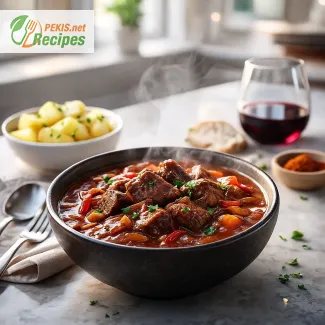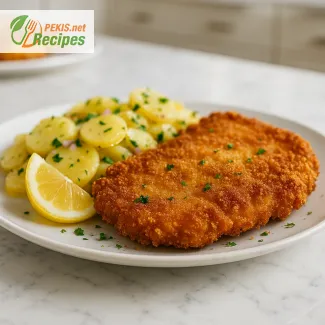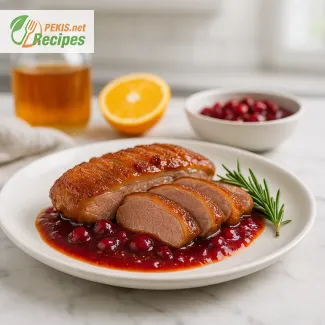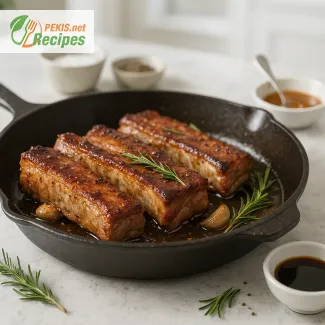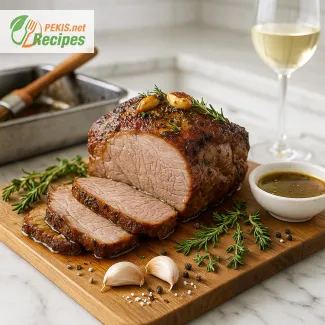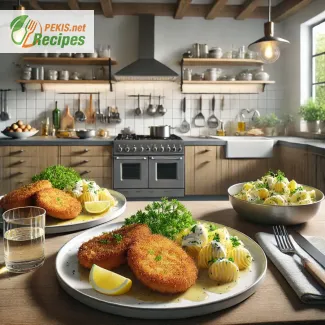
Few dishes encapsulate the heart of European cuisine as perfectly as the original Viennese schnitzel paired with a refreshing potato salad. This celebrated dish, rooted in Austrian culinary tradition, is synonymous with elegance, simplicity, and indulgence. Every bite tells a story of meticulous preparation, the finest ingredients, and a rich cultural heritage that has stood the test of time.
The Art of the Viennese Schnitzel
The hallmark of an authentic Wiener Schnitzel lies in its preparation. Using only the highest-quality veal cutlets, this dish achieves its signature golden-brown crust through a delicate breading process. Each slice of tender meat is pounded to a uniform thickness, ensuring even cooking and a melt-in-your-mouth texture. The combination of flour, egg, and breadcrumbs forms a crispy coating that envelops the schnitzel, creating a satisfying contrast to the juicy, flavorful interior.
Cooked to perfection in clarified butter, the schnitzel boasts a light, airy crust that is neither greasy nor heavy. This careful cooking method elevates the dish, making it a true culinary masterpiece that remains unrivaled in its simplicity and taste.
A Perfect Pairing: The Potato Salad
No Viennese schnitzel is complete without its traditional companion: potato salad. This refreshing side dish offers a delightful balance of flavors and textures, complementing the rich schnitzel beautifully. The potatoes, boiled to tender perfection, are thinly sliced and dressed in a tangy vinaigrette made with mild onions, white wine vinegar, and a touch of mustard. Freshly chopped parsley adds a vibrant note, while a hint of sugar balances the acidity, creating a harmonious blend of flavors.
The potato salad, served slightly warm or at room temperature, provides a light and zesty contrast to the schnitzel, enhancing the overall dining experience.
A Dish That Celebrates Tradition
Originating in Vienna, the Wiener Schnitzel has long been a symbol of Austrian hospitality and culinary excellence. It is often enjoyed in both casual and formal settings, making it a versatile dish that transcends occasions. Whether served at a family gathering, a festive celebration, or in the refined ambiance of a Viennese café, this dish never fails to delight.
Its universal appeal lies in its attention to detail and the quality of ingredients used. Authenticity is key, and every element, from the choice of veal to the precise breading technique, contributes to its timeless charm.
A Culinary Journey Worth Indulging
Savoring a plate of original Viennese schnitzel with potato salad is more than just a meal; it’s an experience that connects you to a rich gastronomic heritage. Each bite is a testament to the art of simplicity done right—proof that sometimes, the most straightforward recipes are the ones that leave a lasting impression.
Perfect for any occasion, this dish invites you to slow down, enjoy the process, and appreciate the care that goes into its preparation. From the crispy, golden schnitzel to the refreshing tang of the potato salad, this pairing promises a culinary experience that is both comforting and indulgent.
Whether you’re recreating it in your own kitchen or enjoying it at a classic Viennese establishment, the original Wiener Schnitzel with potato salad is a celebration of flavor, culture, and tradition. Take a step back in time and treat yourself to a dish that has delighted taste buds for centuries.
Step 1: Prepare the schnitzel
- Place each veal cutlet between two pieces of plastic wrap and pound with a meat mallet until about 4 mm (⅛ inch) thick. Season both sides lightly with salt.
- Prepare three shallow bowls: one with flour, one with beaten eggs, and one with breadcrumbs.
- Dip each cutlet into the flour, ensuring it’s fully coated, then into the beaten eggs, and finally into the breadcrumbs. Press the breadcrumbs gently, but do not flatten the coating.
Step 2: Fry the schnitzel
- Heat clarified butter in a large frying pan over medium-high heat. The oil should be hot but not smoking.
- Fry each cutlet for 2-3 minutes on each side, gently tilting the pan to ensure even frying. The schnitzel should be golden brown and crispy.
- Remove and place on a paper towel-lined plate to drain excess fat.
Step 3: Prepare the potato salad
- Boil the potatoes with their skins on until tender (approximately 20 minutes). Allow to cool slightly, then peel and slice thinly.
- In a small saucepan, heat the vinegar, mustard, sugar, and water or broth. Season with salt and pepper.
- Pour the warm dressing over the sliced potatoes and gently mix. Add the chopped onion and parsley. Drizzle with vegetable oil and let sit for at least 15 minutes for the flavors to meld.
Step 4: Assemble and serve
- Place a schnitzel on each plate alongside a portion of potato salad. Garnish with a lemon wedge for squeezing over the schnitzel.
Enhancing and Modifying the Original Viennese Schnitzel with Potato Salad
The original Viennese schnitzel with potato salad is a timeless classic, but like all great recipes, it offers room for experimentation and personalization. Whether you aim to adapt the dish for dietary preferences, elevate its flavor, or explore new culinary techniques, small adjustments can significantly influence the final result. Here are detailed and professional tips to guide you in modifying this iconic recipe.
Choosing the Right Meat
The traditional schnitzel is made with veal cutlets, prized for their tenderness and delicate flavor. However, alternative meats can offer unique textures and tastes:
- Pork: A popular and more economical substitute, pork schnitzel offers a slightly stronger flavor. The cut should be lean, such as pork loin, to maintain a similar texture.
- Chicken: For a lighter option, chicken breasts provide a mild taste that pairs well with the crispy breading.
- Turkey: Similar to chicken but with a slightly richer flavor, turkey is an excellent choice for a leaner schnitzel.
Impact on flavor: Switching from veal to pork or poultry creates a heartier, more pronounced taste, while still retaining the core appeal of the dish.
Experimenting with the Breading
The breadcrumb coating is essential for achieving the schnitzel’s signature crunch. While traditional breadcrumbs work perfectly, experimenting with alternatives can bring unexpected textures and flavors:
- Panko breadcrumbs: These Japanese-style crumbs create a lighter, airier crust, making the schnitzel extra crispy.
- Gluten-free breadcrumbs: Ideal for those with gluten sensitivities, these alternatives can deliver similar results without compromising on texture.
- Crushed crackers or pretzels: For a unique twist, crushed crackers or pretzels add a slightly salty and nutty flavor.
Impact on flavor: Using different breadcrumbs introduces subtle flavor variations and enhances the schnitzel’s visual appeal with a more textured crust.
Adjusting the Potato Salad
The potato salad is a crucial companion to the schnitzel, offering a tangy and refreshing contrast. Minor tweaks to its ingredients can significantly alter the overall balance:
- Adding herbs: Incorporating fresh dill or chives alongside parsley enhances the salad's freshness.
- Switching dressings: Replace the classic vinegar-based dressing with a creamy yogurt or sour cream base for a richer texture.
- Including vegetables: Add thinly sliced cucumbers or radishes for extra crunch and a burst of flavor.
Impact on flavor: Adjusting the potato salad adds depth and complexity, ensuring it complements the schnitzel while offering new taste experiences.
Cooking Techniques
The method of frying the schnitzel plays a critical role in its final texture and taste. Here are a few variations to consider:
- Shallow frying: The traditional method ensures even cooking and a crisp crust. Use clarified butter for its high smoke point and rich flavor.
- Deep frying: Creates an exceptionally even and crispy coating but may result in a slightly heavier dish.
- Air frying: A healthier option that reduces the amount of oil, though the crust may not be as golden or crisp.
Impact on flavor: Different frying methods subtly alter the schnitzel's texture and richness. Clarified butter remains the ideal choice for traditional flavor.
Flavor Enhancements
For those seeking to amplify the schnitzel's flavor, consider the following additions:
- Spices in the breading: Add paprika, garlic powder, or grated Parmesan to the breadcrumbs for extra flavor.
- Marinating the meat: A light marinade of lemon juice, garlic, and herbs can infuse the meat with subtle undertones.
- Serving sauces: Pair the schnitzel with mushroom cream sauce, Dijon mustard, or even cranberry compote for a flavorful twist.
Impact on flavor: These enhancements elevate the dish from a traditional preparation to a gourmet experience, making it versatile for different occasions.
Dietary Adaptations
Modifying the recipe to suit dietary restrictions doesn’t mean sacrificing taste:
- Gluten-free option: Use gluten-free flour and breadcrumbs to accommodate those with gluten intolerance.
- Egg-free option: Replace eggs in the breading process with a mixture of plant-based milk and cornstarch.
- Vegetarian schnitzel: Substitute meat with thin slices of eggplant or zucchini for a vegetarian version.
Impact on flavor: These adaptations ensure inclusivity without compromising the dish’s core qualities, providing options for diverse dietary needs.
Presentation and Serving Ideas
Visual appeal enhances the dining experience. Consider these tips for plating and serving:
- Layering textures: Stack the schnitzel slightly over the potato salad for a modern presentation.
- Garnishing: Sprinkle chopped parsley or lemon zest over the schnitzel for a fresh finish.
- Side dishes: Complement the dish with steamed green beans or a light cucumber salad for added variety.
The original Viennese schnitzel with potato salad is a masterpiece of culinary simplicity, yet its adaptability allows for endless possibilities. By experimenting with ingredients, techniques, and presentation, you can tailor this classic to suit personal preferences or dietary requirements. These thoughtful modifications not only expand its appeal but also ensure it remains a dish to be enjoyed by all.
Contains: Gluten (breadcrumbs, flour), Eggs
Substitutions:
- Replace flour and breadcrumbs with gluten-free alternatives to make it gluten-free.
- Use aquafaba (chickpea water) instead of eggs for an egg-free version.
- Vitamin B6: Supports brain health and energy metabolism.
- Vitamin C: Boosts immunity and promotes skin health.
- Potassium: Regulates blood pressure and heart function.
- Iron: Supports red blood cell production and prevents anemia.
- Vitamin E: Found in the oil, helps protect cells from oxidative stress.
- Parsley: Contains flavonoids that reduce inflammation and support overall health.
